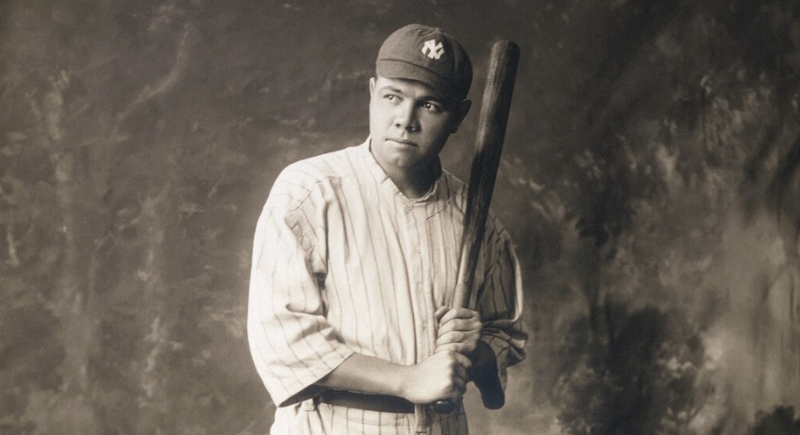Top 10 Greatest Two-Way Players in Sports
Balancing two roles in professional sports demands endurance, adaptability, and a rare ability to impact the game in multiple ways. Only a handful of athletes have managed to succeed in two distinct areas at once.
They changed how people viewed versatility and left lasting marks on their sports. Their stories reveal the extent of the gap between being “good at both” and being “great at both.”
Babe Ruth

Image via Wikimedia Commons/Irwin, La Broad, & Pudlin.
Before Ruth became baseball’s most famous slugger, he was a dominant pitcher for Boston. He posted a 2.22 ERA in 1918, threw over 160 innings, and followed with another strong season in 1919. Then he shifted to full-time hitting and rewrote baseball’s record book for offense. His combined WAR—162.7 as a hitter and 20.4 as a pitcher—shows how rare it is to reach elite levels in both roles. Ruth’s overlap years were brief, but so successful that even the limited time spent on both secured his spot at the top of any two-way discussion.
Bullet Rogan
Bullet Rogan was a true two-way player; he both pitched and hit regularly. In 1925, he went 15–2 with a 1.74 ERA and hit .360 in the same season. Throughout the 1920s, he played regularly as both a pitcher and an outfielder, while maintaining top-tier performance in each role.
Martin Dihigo
Dihigo, known in Cuba, Mexico, and the United States, played nearly every position on the field. In nine recorded U.S. seasons, he ended with a 3.34 ERA and hit .307 with power. In 1926, he led the Eastern Colored League in batting average, slugging, and OPS while ranking among the top pitchers for WAR. His adaptability defined his run, but it was his consistent excellence that earned him Hall of Fame honors in multiple countries.
Joe “Smoky Joe” Wood

Image via Wikimedia Commons/Bain News Service
While rebuilding his career in the outfield after arm injuries, Joe Wood managed one of the most effective transitions in baseball history. His 1912 season as a pitcher—34 wins, a 1.91 ERA, and three World Series victories—showed his early dominance. Over five years in Cleveland, he played in more than 400 games and hit .298 with a 116 OPS+ rating.
Shohei Ohtani
If there’s anyone who revived the concept of a true two-way player in modern baseball, it’s Shohei Ohtani. By 2021, he was already delivering top-tier results as both a pitcher and hitter in the same season. His fastball overpowered hitters, and his bat produced consistent home run power.
Ted “Double Duty” Radcliffe
The nickname “Double Duty” is self-explanatory—Ted Radcliffe caught one game and pitched the next more than once. Across a long career, he earned All-Star selections in the two roles, a rare achievement even among two-way players. His 3.68 ERA stood well above league average, and he led the league in ERA in 1930. While his batting numbers remained modest, his defensive skills and ability to manage games behind the plate made him an essential player to every roster.
Leon Day
Short league schedules and wartime interruptions limited the number of games, but the available records still show how effective Leon Day was in every role he played. In 1942, he posted an 8–2 record with a 1.73 ERA and led the league in strikeouts and WHIP. Day’s quick delivery, fielding range, and consistency made him one of the most well-rounded contributors of his era, despite having fewer opportunities than many of his peers.
Bucky Walters

Image via Wikimedia Commons/History Write
Walters began his major league stretch as an infielder but was encouraged to pitch after teammates noticed his strong arm. The change transformed him into one of the National League’s best pitchers. His time as a hitter was brief, yet significant enough to qualify as a two-way contribution. Consequently, the athlete’s early experience at third base gave him an understanding of both perspectives.
Bob Smith
After starting out as a shortstop for the Boston Braves, Bob Smith eventually found his stride on the mound. A mid-tenure shift to pitching led to 13 seasons, 229 starts, and a 100 ERA+, which placed him right at league average in run prevention. At the plate, his .242 average stood out for a pitcher.
Rick Ankiel

Image via Wikimedia Commons/Barbara moore
As a young left-handed pitcher, Rick Ankiel looked like a future ace after an 11-win rookie season in 2000 and a second-place finish for Rookie of the Year. However, severe control issues cut his pitching career short. Rather than leave the game, he returned as an outfielder and went on to hit 76 home runs while batting .242 over six seasons. His two-way success came in separate chapters, but few players have ever managed such a transition.